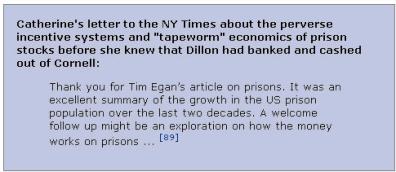Dillon Read (18): Liquidation of Every Place
A Serialised Story - Part 18 of 20 (publishing August/September 2007)
Dillon Read & Co. Inc.
And the Aristocracy of Stock
Profits
By Catherine Austin
Fitts
Click Here For Links To Other Chapters http://www.scoop.co.nz/stories/HL0708/S00302.htm#2
Chapter 17: Private Banking & the Profitable Liquidation of Every Place
 In December of 1998,
during the period when Dillon Read cashed out of Cornell
Corrections and $59 billion went missing from HUD, Time
Magazine published an article, “Just Hide Me the Money”
by S.C. Gwynne with reporting by Adam Zagorin about the
October 1998 Citicorp and Travelers merger and the world of
offshore banking:
In December of 1998,
during the period when Dillon Read cashed out of Cornell
Corrections and $59 billion went missing from HUD, Time
Magazine published an article, “Just Hide Me the Money”
by S.C. Gwynne with reporting by Adam Zagorin about the
October 1998 Citicorp and Travelers merger and the world of
offshore banking:
“Citibank's private-banking unit holds more than $100 billion, which makes it about the same size as the entire bank was in 1982. These funds are in turn part of a $17 trillion global pool of money belonging to what bankers euphemistically call 'high- net-worth-individuals' — a pool that generates more than $150 billion a year in banking revenue. The numbers are impressive when you consider that except at a few sleepy British and Swiss institutions, the private-banking industry didn’t exist until the 1980s. Citibank predicted early this year that it would reach $1 trillion — that's trillion with a T — in private-banking assets by the year 2010. And it faces some 4,000 competitors, from global dreadnoughts like Switzerland's UBS [AUTHOR’S NOTE: the bank that bought Swiss Bank Corporation after Swiss Bank Corporation bought Dillon Read] to secretive banks in the tiny principality of Andorra to brokerages in Miami and accountancy firms in the Channel Islands.”
One of the offshore Dillon funds that invested in Cornell Corrections was Concord Partners Japan Limited. Its officers and directors, as listed in Exhibit D to Dillon's April l997 13-D filing with the SEC, include an impressive array of Japanese business leaders and a non-person, Amerex, S.A, which lists a Coutts private bank address in the Bahamas as its address. This Dillon fund provides a link between the privatization of prisons, offshore funds and arguably the most prestigious private bank in the world. With the anticipation of profits as prisons stocks increased in value and went public, an all-too-familiar impersonal financial mechanism was now in place that created yet another incentive system with global reach, to drive the financial returns of investors up by driving down the Popsicle Index of faceless people and communities, far removed.
According to Wikipedia online encyclopedia:
“Coutts has its headquarters at 440 Strand, London, with branches throughout the UK and the rest of the world. It is a private bank, which means its clients are by invitation only and have liquid assets in excess of £500,000 (AUTHOR'S NOTE: approximately $860,000 U.S. dollars) or an investment portfolio of over £1,000,000. [AUTHOR'S NOTE: approximately $1.72 million U.S. dollars] The bank is most famously known in the UK as the banker of Her Majesty Queen Elizabeth II. A Coutts Automated Teller Machine is installed in the basement of Buckingham Palace for use by the Royal Family… Coutts is known as the “Queen's Bank” to many by virtue of it being reputed to be the bankers to the British Royal Family. Within the UK it is the largest Private Bank… Historically Coutts was an upper crust clearing bank to the landed gentry, but today they are seen as wealth managers willing to accept a wider class of clientele, including top sportsmen, lottery winners, football stars, businessmen, chief executives, and pop singers. You don't have to be “Posh” to get in, but if you are, it helps.
“As well as being the Queen's banker, Coutts is also known as a bank for the rich and famous of British society. In 1999 it became known that Her Majesty Queen Elizabeth, the Queen Mother had a £6 million [AUTHOR’S NOTE: approximately $10 million U.S. dollars] overdraft with the bank. Sarah, Duchess of York also had a large overdraft with the bank worth around £8 million [AUTHOR’S NOTE: approximately $13.8 million U.S. dollars], which was subsequently paid off.”
 So, let’s say I am
a customer of a private bank such as Coutts. Let’s say
through Coutts I have an interest in an offshore fund with
private prison investments. The more people who are rounded
up and put into prison, the more valuable my investment
becomes. If laws are passed for mandatory sentences, the
more valuable my investment becomes. If politicians and
political appointees push through more prison contracts for
private companies, the more valuable my investments become.
The more enforcement staff and arrests, the more valuable my
investments become yet again.
So, let’s say I am
a customer of a private bank such as Coutts. Let’s say
through Coutts I have an interest in an offshore fund with
private prison investments. The more people who are rounded
up and put into prison, the more valuable my investment
becomes. If laws are passed for mandatory sentences, the
more valuable my investment becomes. If politicians and
political appointees push through more prison contracts for
private companies, the more valuable my investments become.
The more enforcement staff and arrests, the more valuable my
investments become yet again.
I can of course borrow on the increased value of my portfolio without ever having to sell my investment, so I can watch my investment grow, receive distributions based on profitability and still enjoy the liquidity it provides. In fact, given the wonders of modern banking, I can turn my investment into ready cash with my ATM card, just as the personal staff for the British Royal Family presumably can through the Coutts ATM machine in the basement of Buckingham palace. Indeed, the transatlantic slave trade never dreamed of financial leverage, engineering and liquidity this pervasive, instantaneous or socially respectable.
But perhaps this should all make us pause for a moment and think. If the housing bubble turned our homes into ATM machines and in turn induced many of us to take on debt beyond our means, will the privatization of our prison system provide incentives for those profiting from such investments to support policies that make us even more of a target in the future?
 [89]
[89]Recently, I called the Washington, D.C. criminal attorney who represented The Hamilton Securities Group with respect to the criminal investigation until 1998. I asked him if DOJ had managed to frame me, where would it have sent me to prison? He said the order would have gone from the court to the Federal Bureau of Prisons at DOJ, and that it would have had the discretion to send me to the prison of its choice. Hence, it was possible that I would have been incarcerated in a Cornell Corrections prison. How ironic would that have been? I now have the satisfaction of knowing that at the cost to me of millions in litigation and investigation expenses over a ten year period, I may have denied my old partners and colleagues at Dillon Read and their domestic and offshore investors another $11,000 in stock profit — approximately 44% (Dillon's percent ownership) of the increased value in Cornell Corrections stock from another “bed” being occupied by yours truly.
FOOTNOTES
[89] Catherine's letter to the NY Times about the perverse incentive systems and "tapeworm" economics of prison stocks before she knew that Dillon had banked and cashed out of Cornell:SOLARI
Letters to the Editor
New York Times
letters@nytimes.com
Tim Egan's Article on Prisons, March 7, 1999
Ladies and Gentlemen:
Thank you for Tim Egan’s article on prisons. It was an excellent summary of the growth in the US prison population over the last two decades. A welcome follow up might be an exploration on how the money works on prisons.
The federal government has promoted mandatory sentences and taken other steps that will increase the overall prison population to approximately 3 million Americans as recently legislated policies finish working their way through the sentencing system. This means that approximately 10-15 million Americans will be under the jurisdiction of the criminal justice system from arrest, to indictment, to trial, to prison, to probation and parole.
The enactment of legislation ensuring the growth of prisons and prison populations has been a bipartisan effort. Republicans and Democrats alike appear to have found one area where we can build consensus for substantial growth in government budgets, staffing levels and media attention. Indeed, during this period, the number of federal agencies with police powers has grown to over 50, approximately 10% of the American enforcement bureaucracy. This is further encouraged by federal laws permitting confiscation of assets such as homes, cars, bank accounts, cash, businesses and personal property that can be used to fund federal, state and local enforcement budgets.
One way to look at the financial issues involved is to view them from the vantage point of the portfolio strategists of the large mutual funds. We have approximately 250-280 million people in America. The question from a portfolio strategist standpoint is what productive value will each one be creating in companies and communities and how does that translate into flow of funds that then translate into equity values and bond risk.
The prison companies are marketing one vision of America with their prison and prisoner growth rates, while the consumer companies are marketing another. The two are not compatible. CCA’s assumptions regarding the growth in arrests and incarceration can not be true if Fannie Mae’s, Freddie Mac’s and Sallie Mae’s assumptions about homeownership and college education rates are. We, the people, cannot refinance our mortgages or buy homes or raise our children and send them to college if we are in jail. Meantime, the municipal debt market is also facing conflicting positions. If prison bonds are a good investment, then some general obligation bonds may in trouble. We, the taxpayers, cannot support the debt: we are no longer taxpayers. We have become prisoners. Whatever we are generating in prison labor, it is certainly not enough to pay for the $154,000 per prisoner per year costs indicated for the full system by the General Accounting Office.
It would be very illuminating to get the rating agencies and the ten largest mutual funds together in one room for an investor roundtable to discuss pricing levels on the investment of our savings that is internal to their portfolios and ratings. We would compare equity valuations and growth rates of:
-- Companies who make money from the American people losing productivity
-- Companies who make money from helping the American people grow more knowledgeable and productive.We are investing in two different visions that cannot both come true.
We could then calculate which was going to succeed, and what the integrated pricing level would be. Better yet, what could happen that would make the most money for the investment community? The question is which vision is best for we, the equity investors of America? And why are investors assuming both win as they price their stocks and bonds?
It is critical to look at prison policy from the standpoint of maximizing return on equity investment. It would be a terrible thing, while I can no longer pay taxes or buy a house or send my son to college because I am in prison, if my vested pension benefits were wiped out by the time I re-entered society. It is bad enough that my life savings are being invested in companies that make money from promoting that me and my family should be arrested and incarcerated. It would be worse if I and my family were broke because companies that make money from loss of productivity turned out to also be a bad investment.
Such a roundtable might make for a great New York Times article. If you are willing to take it on, Solari would be happy to assist your staff by contributing background analytics on how the money works in prisons.
Sincerely Yours,
Catherine Austin Fitts
 Mapping The Real Deal is a column on
Scoop supervised by Catherine Austin Fitts. Ms Fitts is the
President of Solari, Inc. http://www.solari.com/. Ms. Fitts is
the former Assistant Secretary of Housing-Federal Housing
Commissioner during the first Bush Administration, a former
managing director and member of the board of directors of
Dillon Read & Co. Inc. and President of The Hamilton
Securities Group,
Inc.
Mapping The Real Deal is a column on
Scoop supervised by Catherine Austin Fitts. Ms Fitts is the
President of Solari, Inc. http://www.solari.com/. Ms. Fitts is
the former Assistant Secretary of Housing-Federal Housing
Commissioner during the first Bush Administration, a former
managing director and member of the board of directors of
Dillon Read & Co. Inc. and President of The Hamilton
Securities Group,
Inc.


 Keith Rankin: Geopolitical Fractures, And Untidy Yet Workable Solutions
Keith Rankin: Geopolitical Fractures, And Untidy Yet Workable Solutions Gordon Campbell: On Winston Peters’ Battle Against The Phantom Legions Of The Woke
Gordon Campbell: On Winston Peters’ Battle Against The Phantom Legions Of The Woke Adrian Maidment: Road Cone Final Exam & Donald, I Warned You!
Adrian Maidment: Road Cone Final Exam & Donald, I Warned You! Binoy Kampmark: The Script Of Anxiety - Poland’s Nuclear Weapons Fascination
Binoy Kampmark: The Script Of Anxiety - Poland’s Nuclear Weapons Fascination Martin LeFevre - Meditations: Regarding Randomness And Significance
Martin LeFevre - Meditations: Regarding Randomness And Significance Ian Powell: When Apartheid Met Zionism
Ian Powell: When Apartheid Met Zionism